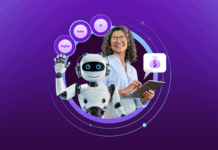In an age where customers are accustomed to interacting through chat, voice, and video in their personal lives, shouldn’t they be able to do the same with the businesses they choose to purchase from?
- Customers should be able to engage with companies in whatever way they’re most comfortable with and–if needed–move seamlessly to other modes of communication.
- When an agent interacts with a customer, they should be able to see the customer’s screen to instantly understand the customers’ point of view, and be their co-pilot to a satisfying experience.
Businesses are not blind to the need to add more digital features to their service menus. They may make noble efforts to provide varying forms of multi-channel support, but all too often these fall short as a result of disconnected, bolt-on, point solutions instead of optimized and unified parts of a holistic customer strategy. This fragmented approach typically results in suboptimal customer experience and satisfaction.
“Customers do not have strong channel preferences and prioritize obtaining a resolution above all else. Service leaders should focus their efforts on resolving customer issues completely via self-service channels with only the most complex cases being directed to live-channel reps to deliver a high-quality service experience and maintain customer loyalty.”
– Gartner, “Build a Successful Digital Customer Service Strategy”
When companies adopt a Digital Customer Service (DCS) model, it creates a very different experience–one that meets and exceeds the ever-more-demanding expectations of today’s digital-first customers.
A simple way to think about the benefits DCS brings to an interaction is by remembering the acronym PACE. These are the four broad elements of DCS that distinguish it from the service experiences most companies are currently delivering:
- Personalize: The experience should be ABOUT the customer–not just that they are recognized by name, but there is a demonstrated level of understanding about that person’s history with a company, the nature of their past interactions and what they are likely seeking from the company at that moment.
- Automate: Through the use of integrated AI and machine learning, bots can be instantly triggered based on certain keywords, issue descriptions or click patterns. If a customer only needs to obtain information or perform a simple self-service task, these can be accomplished in a fully-automated manner without the need for live assistance.
- Contextualize: If a live agent is called into the customer’s resolution journey at any time, through Live Observation and CoBrowsing they are able to join the discussion in mid-stream (where the customer is at that moment), rather than forcing them to start the interaction all over again at the beginning.
- Educate: We’ve all heard it a million times: “Give a person a fish and they will eat for the day. Teach a person to fish and they will eat for life.” Instead of conducting a transaction for a customer, in DCS an agent can enable a customer to complete the transaction themselves (with a bit of helpful guidance), in a way that inspires customers to be more confidently self-sufficient in the future.
As you can see, each of these elements of DCS was created as a direct response to the negative experiences so many customers have reported in the past when interacting with companies whose customer service “machine” was built on a disconnected multichannel chassis.
If digital-first customers were enabled to build their own “personal” customer service platform–with their own needs and preferences in mind–wouldn’t it likely include P-A-C-E?





